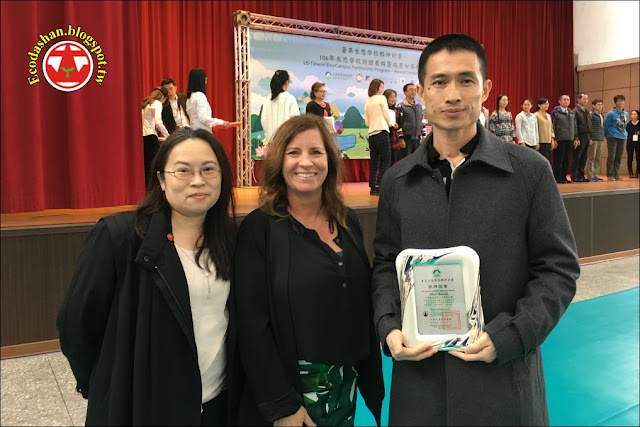 |
| The “Silver Award” of US-Taiwan Eco-campus Certification issued by NWF, USA |
 |
| A glorious achievement of Dashan Elementary |
1.Introduction to Dashan Elementary
Dashan Elementary School has been established for more than 77 years in Miaoli County and the school is located near the Taiwan Strait and between the Zhonggang River and Houlong River. Because of a vast farmland around school, the pupils can engage in meaningful learning beyond the textbooks, especially in the “sustainable food” pathway. The eco-action team, started operation 18 months ago, is composed of pupils including grade 4 to 6, teachers, principal and parents.
 |
| A vast farmland around school |
2.Award of Eco-Campus
2-1. Bronze Award through “Sustainable food” pathway:
With the involvement of community, pupils planted organic rice through traditional way. First step, children transplanted the rice seedlings by hand in July. Then they weeded the farm 2~3 times by hand within 3 months. As winter coming, pupils went back the farm again and harvested the rice by hand.
 |
| “Sustainable food” pathway |
 |
| Organic campus with chickens |
2-2. Silver Award through “Energy” pathway:Furthermore, we completed an “Energy” audit from April to June this year. Firstly, pupils investigated energy use of the school by collecting electricity bills of the past 3 years. Besides, they also surveyed the amount of electronic devices, for instance, lights, desktop computer, computer monitor, printer, scanner, copier, DVD/CD player and so on. Then they recorded the energy data and created some tables and diagrams to analyze the energy-using trend. After the analysis they discussed some rules for saving energy. The next step, they drew some posters about the data analysis and the rules of saving energy. Finally, the eco-action team cooperated to publicly report what they investigated, analyzed and created in children’s morning assembly time. Of course they also recommended the rules for efficiently using energy to all members in school. The team not only fostered capacities for collecting, analyzing data but also raised skills in creating diagrams and tables and expressing. Therefore, Dashan Elementary received the Silver Award through “Energy” pathway on October 17, 2017.
 |
| “Energy” pathway |
3.Eco-Code
After the environmental audit for “Energy” pathway, we created an action plan. Pupils monitored and evaluated the plan, and engaged in learning about energy. Finally we discussed the eco-code for several times in action meetings. Children also made some notices with eco-code and pasted them near the light switches. The eco-code is:
“If necessary, we use energy reasonably, otherwise we save it.
Remember to turn off the light for taking good care of our Earth.”
(當用則用,能省就省,隨手關燈,愛護地球。)
 |
| “Energy” pathway |
4-1. South Florida Habitats:
Our partner, Tequesta Trace MS in Florida, carried out a project of “South Florida Habitats” and mailed it to us. Then, our pupils collaborated to study the result (PPTs) to explore South Florida’s ecology. After several meetings for sharing, the eco-action team presented the result of “South Florida Habitats” project in English for whole school. This is a very successful instance of the Global PBL.
 |
| The Global PBL of “South Florida Habitats” |
After that, we also carried out an ecological survey for campus and community, children used the "Scientific Drawing" to record various creatures such as flowers, butterflies, beetles, mantises and bees. They are just like those naturalists such as Darwin and Fabre in 19th century. Then the exhibition of "Scientific Drawing" is held on our school anniversary day. Each creator explained his/her drawing about ecology to parents or others from the community. Pupils also shared the amazing results with partner school, Tequesta Trace MS in United States, through the internet to reply the project of “South Florida Habitats”. This is another successful example of the Global PBL.
 |
| Scientific Drawing |
5-1. Cross-disciplinary learning:
Based on the linking to the curriculum of the "Biodiversity" pathway, pupils engaged some cross-disciplinary learning. For instance, they cooperated to write some ecological stories such as milkweed butterflies, bees, stink bugs and leopard cats. Then they designed the handmade English books with drawing pictures. Besides the knowledge and skill learning, children also fostered the capacity of positive social interaction through the teamwork.
Recently, children tried to make “branch insects” which is another highlight of eco-campus program. They learned to observe the details of insects and seek branches and leaves on campus. Then they designed the structure of a cicada such as two eyes, three pairs of legs and wings. The next step is to calculate, cut and drill the wood. Finally, pupils combined the materials according to their own blueprint. In the process of learning, they looked like the biologists, also like the carpenters, even like the artists.
 |
| Making the “branch insects” |
5-2. Integrated curriculum:
For implementing our eco-campus program, we designed the “Integrated curriculum” which contains several disciplinary areas including English, mathematics, natural science and technology, Mandarin, social studies, arts and humanities. Referring to the curriculum diagram, the paths of our International Exchange are through the “Mail Ship” and “Internet” such as Blog, E-mail, Google Sites, iEARN and YouTube. This curriculum is also a representation of “Local Learning, Synchronizing with the World”. (Dashan Elementary School, 06/12/2017)
 |
| The diagram of integrated curriculum |

沒有留言:
張貼留言
注意:只有此網誌的成員可以留言。